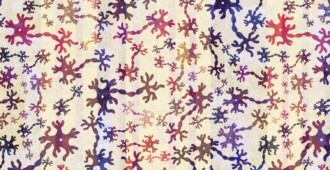Today some exciting news about the genetics of MND was published in the scientific journal Nature Genetics. The results come in two research papers published in the same issue of the journal.
This blog post discusses the results of the first of these papers for which King’s College London based Professor Ammar Al-Chalabi was one of the leading researchers. A post on the second paper will follow later.
Here we’ve given an overview of what the researchers have found, what it means for people with MND and how the analysis was conducted. You can read a more detailed explanation of the research results from the King’s press release.
What did the researchers find?
The research found that people who have a rare variation of a gene called C21orf2 are at an increased risk of developing MND.
Two further gene ‘postcodes’ (technically known as a gene loci) for genes called MOBP and SCFD1 are also seen more often in people with MND – suggesting that variations in these genes are risk factors for getting MND too. (If you like this is just one level of ‘proof’ or evidence down from saying these genes are definitely involved).
Variations in a gene called TBK1 (which we’ve written about before) were also found to increase the risk of people developing MND.
What does this mean for people with MND?
We already know that genetics play an important role in why some people get MND. Usually research results on genetics tell us more about the rare, inherited form of MND – where there’s a family history of the condition and affecting around 10% of all cases of MND. ( You can read more about what we know of the genetic contribution to MND on our website ).
However, these results are different as they tell us about variations that may contribute to why people who don’t have that family history get MND. These genetic variations interact with lifestyle and environmental factors to cause MND. As well as telling us what one of these variations is – it also tells us new information on how many of these gene variations there might be, and how much each of them adds to the risk of getting MND.
It’s the first time that the C21orf2 gene has been linked to MND. It sheds light on a whole new area of biology that few MND researchers had looked at previously. It could give us important clues for understanding MND, and ultimately developing new treatments.
How was the research conducted?
This was a truly worldwide collaboration. It involved many researchers from many different countries sharing DNA samples that they had collected. We are proud that it included samples from the UK MND DNA Bank (that the MND Association looks after and that so many people with MND in the UK contributed to).
By sequencing the DNA of approximately 15,000 people with MND and 26,000 healthy ‘controls’, the researchers were able to identify these certain genetic changes (as above) which are more common in people with MND.
The technique, called whole genome sequencing, involves looking at each ‘letter’ that makes up our genetic code – this is approximately 6 billion letters, which means a lot of data for the researchers to look through.
How was the MND Association involved?
The MND Association first funded a project involving genome sequencing in 2006, when this technique was still relatively new. That study, led by Prof Al-Chalabi and Prof Bob Brown (based at Harvard, USA), had an initial target of analysing 2,600 samples from people with MND and 2,600 control samples.
Reflecting back on this project and the advances in genome sequencing, the Association’s Director of Research Development Dr Brian Dickie said:
‘We are pleased to have been involved since this approach to gene hunting was in its infancy a decade ago. It’s so encouraging to see how the collaboration, catalysed by Project MinE, has grown and is now delivering results that will open up new avenues of research across the world.’
This study was funded from many organisations including the crowd-sourced funding of Project MinE. In the UK funding came from the MND Association, the EU Joint Programme on Neurodegeneration Research through the UK Medical Research Council and the EU FP7 Programme EuroMotor.
van Rheenen et al Nature Genetics 2016 ( doi:10.1038/ng.3622 )






You can read the whole paper here:
http://rdcu.be/jrw0
hi I was diagnosed in 2014. I would take part in any trial that is available regarding MND. thank you
Dear Thomas,
Thank you for offer of taking part in an MND trial, your help is appreciated. There are a few studies that you can take part in at the moment. These are listed on our ‘Get involved in research’ section of our website: http://www.mndassociation.org/research/mnd-research-and-you/get-involved-in-research/.
With best wishes,
The Research Development team